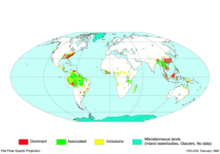Acrisol
Acrisol (AC) is a reference floor assembly from the World Reference Base for Soil Resources (WRB). Acrisols are acidic soils characterized by shifting clay (lessivization). The clay fraction is dominated by kaolinite . Acrisols occur on ancient land surfaces of the humid tropics and subtropics. The diagnostic horizon is the argic horizon (Bt) characterized by tone enrichment .
The typical horizon sequence according to the FAO Guidelines for Soil Description is:
- A - topsoil with often only low humus contents
- E - clay depletion horizon ( eluvial )
- Bt - clay enrichment horizon ( illuvial ) in the subsoil
- C - parent rock
description
The prolonged, severe weathering led to the dominance of exchange -poor clay minerals ( low-activity clays ). The dominant clay mineral is kaolinite , there is also halloysite , but also small amounts of 3-layer clay minerals . The potential cation exchange capacity in parts of the Bt horizon is <24 cmol c / kg clay. The Bt horizons in particular are often colored red, which is due to the formation of the iron oxide hematite . The leaching of silica and the simultaneous accumulation of kaolinite and oxides is called ferrallitization . Acrisols occur in damp areas and have a low effective base saturation <50% in the subsoil , which is associated with low pH values, from which the name (Latin acer , acidic) is derived. The low contents of clay minerals and oxides in the topsoil offer only few possibilities for stabilizing the organic substance against microbial degradation, which is why most acrisols are relatively poor in humus and have poorly aggregated topsoils that are at risk of erosion.
The low cation exchange capacity, the low pH values and the lack of clay and humus in the topsoil combined with poor aggregation pose considerable problems for agriculture. Traditionally, shifting cultivation is practiced. In plantation farming they are most suitable for aluminum-tolerant crops such as tea, rubber or oil palms. Grazing with cattle or forestry is common.
Related soil types
The WRB knows five reference soil groups with an obligatory argic horizon . Only the retisols have additional retic properties. The other four do not have any and are differentiated according to potential cation exchange capacity per kg clay (KAK / kg clay) in the argic horizon and effective base saturation (BSeff) in the subsoil. With the Luvisoles , both are high. In the case of the alisols , the KAK is high and the BS is low. The KAK is low and the BS high for the Lixisols , and both are low for the Acrisols.
Web links
- Profile photos (with classification) WRB homepage
- Profile photos (with classification) IUSS World of Soils
literature
- IUSS Working Group WRB: World Reference Base for Soil Resources 2014, Update 2015. World Soil Resources Reports 106, FAO, Rome 2015. ISBN 978-92-5-108369-7 ( PDF 2.3 MB).
- W. Zech, P. Schad, G. Hintermaier-Erhard: Soils of the world. 2nd Edition. Springer Spectrum, Heidelberg 2014. ISBN 978-3-642-36574-4 .
- W. Amelung, H.-P. Blume , H. Fleige, R. Horn, E. Kandeler , I. Kögel-Knabner , R. Kretschmar, K. Stahr , B.-M. Wilke: Scheffer / Schachtschabel textbook of soil science. 17th edition. Heidelberg 2018. ISBN 978-3-662-55870-6 .
- FAO: Guidelines for Soil Description. Prepared by R. Jahn, V. Asio, H.-P. Blume , O. Spaargaren and P. Schad. Rome 2006. ISBN 92-5-105521-1 .


